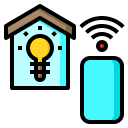The Evolution of Connected Devices
Connected devices have revolutionized the way we interact with technology, integrating seamlessly into our daily lives and transforming industries worldwide. From the earliest examples of wired machines to the sophisticated network of smart devices today, the development of connected devices has driven unprecedented convenience, efficiency, and innovation. This ongoing evolution continues to shape the future, merging physical objects with digital intelligence to create a more connected world.

Early Foundations of Connectivity
The Birth of Communication Networks
Long before the internet, telephone lines and telegraphs provided the first methods for exchanging data between remote locations. Engineers and inventors developed intricate networks using copper wires and switching stations to connect cities and countries. This initial infrastructure demonstrated the immense value of linking devices over distances, enabling the acceleration of commerce, government, and personal communication. Over time, these networks evolved in complexity and reliability, setting the template for more advanced systems that would one day support global digital connectivity. The fundamental principles established by these early networks continue to influence modern approaches to communication.
Transition to Early Digital Devices
As technology advanced, analog systems gave way to digital devices that further expanded the scope of connectivity. Early digital computers could be linked through local area networks, allowing for resource sharing and collaborative work. These advancements made it possible for organizations to process large volumes of data and execute complex tasks remotely. The shift from analog to digital not only improved speed and accuracy but also paved the way for standard communication protocols, which enabled devices from different manufacturers to interact seamlessly. This era marked a crucial turning point, bridging the analog past with the digital future.
Laying the Internet’s Groundwork
The development of the internet in the late twentieth century was a monumental milestone in the story of connected devices. Researchers and scientists collaborated to design networks that could withstand disruptions and support widespread communication. The introduction of TCP/IP protocols enabled devices of various types to participate in expansive interconnected systems. This breakthrough democratized access to information and made it feasible to connect not just computers, but an ever-widening array of devices. The foundational role of the internet cannot be overstated, as it provided the backbone for most modern connected devices and set the stage for today’s digital world.


Proliferation of Personal Computers
The increasing affordability and availability of personal computers in homes and offices brought unprecedented levels of connectivity to individuals. Equipped with modems and network interfaces, these machines granted users access to the World Wide Web and email, revolutionizing how people found information and communicated. The ability to connect to online services transformed education, entertainment, and commerce, making digital interaction a staple of daily life. The rapid adoption of personal computers marked a shift towards individual empowerment in the digital landscape, forming the cornerstone for future generations of connected devices.

Emergence of Mobile Technology
The development of smartphones and mobile networks fundamentally altered the trajectory of device connectivity. Suddenly, people could carry powerful, internet-connected computers in their pockets wherever they went. Innovations like mobile apps, location-based services, and instant messaging made communication and access to information more immediate than ever before. Mobile technology blurred the boundaries between work and leisure, enabling productivity and entertainment on the go. As adoption soared around the globe, it became clear that the future of connectivity would be shaped as much by portability and wireless communication as by raw computing power.
Ubiquitous Sensing and Data Collection
IoT devices are equipped with a wide variety of sensors capable of capturing data on temperature, movement, humidity, location, and countless other conditions. These sensors create a persistent, real-time stream of information about the environment, which can be analyzed for insights or used to automate processes. The ability to collect granular data on such a vast scale has empowered industries to optimize operations, enhance safety, and reduce waste. Individuals, too, benefit from insights into their homes, health, and habits, making quotidian life more informed and efficient than ever.
Smart Cities and Infrastructure
The integration of connected devices into public infrastructure is transforming urban environments into smart cities. Sensors in traffic lights, water systems, and public transit networks collect vital data that city planners use to optimize resources and improve services. Connected streetlights can adjust brightness based on activity, saving energy, while smart grids ensure more reliable and sustainable power distribution. These developments make cities more livable, environmentally conscious, and capable of responding dynamically to residents’ needs. The future promises even greater advancements as governments and stakeholders collaborate to create safer, more efficient urban landscapes through connected technology.
Industrial and Healthcare Revolution
In industries like manufacturing and healthcare, connected devices are ushering in a new era of efficiency, reliability, and innovation. Machines fitted with sensors can detect early signs of wear, preventing costly breakdowns and optimizing maintenance schedules. In hospitals, connected equipment monitors patient vitals in real-time, enabling prompt intervention and better outcomes. Remote diagnostics and telemedicine expand access to care, breaking down geographical barriers. The industrial and healthcare sectors continuously pioneer advanced applications of IoT, leading to safer workplaces, improved productivity, and enhanced patient well-being.
